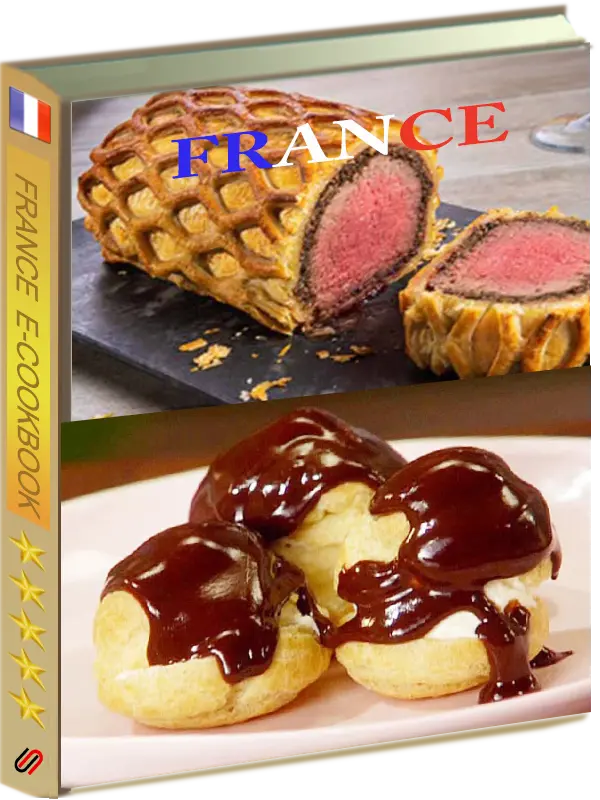The {Page-Turner-Cookbook} featuring
korea Is My Kitchen
KOREA Breakfast Appetizers & Soups
KOREA Main Dishes
liquid Measures
Weight & temperature Measures
non-liquid ingredients
Top 5 countries
Last Page
Weight & temperature Measures
non-liquid ingredients
Top 5 countries
Last Page
North Korean cuisine is part of the wider Korean cuisine, but with some influence from Manchurian/Chinese dishes, as well as a more contemporary take on western food.
Some of the staple foods in North Korea are rice, noodles, kimchi, bulgogi, and soju.
North Korean food tends to be less spicy and more sour than South Korean food, and it also uses more fresh ingredients.
Some of the dishes that originated in North Korea are naengmyeon (cold noodles), chokbal (pig’s trotters), and kajami shik’ae (fermented flounder).
North Korea also has some street food, such as cookies, dumplings, and sweet potatoes, and its first pizzeria opened in 2009.
Some of the staple foods in North Korea are rice, noodles, kimchi, bulgogi, and soju.
North Korean food tends to be less spicy and more sour than South Korean food, and it also uses more fresh ingredients.
Some of the dishes that originated in North Korea are naengmyeon (cold noodles), chokbal (pig’s trotters), and kajami shik’ae (fermented flounder).
North Korea also has some street food, such as cookies, dumplings, and sweet potatoes, and its first pizzeria opened in 2009.
Appetizer Kimchi 
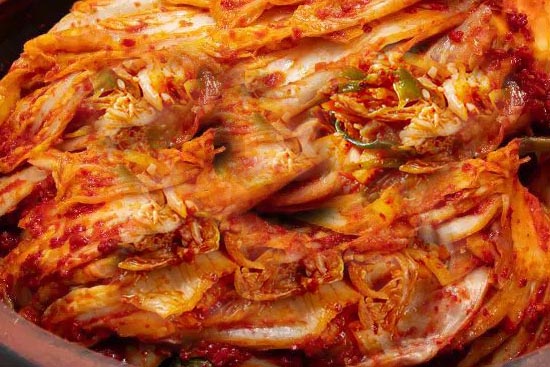
Serves: 4
Preparation time:30 minutes
1 large head napa cabbage1/2 cup kosher salt
1 gallon water
6 cloves garlic, minced
1 1/2 teaspoons minced ginger, peeled
3 tablespoons fish sauce
1 tablespoon cider vinegar
2 teaspoons sugar
1/2 cup Sriracha
6 scallions, both white and green parts, sliced
1 large carrot, peeled and grated
Steps to Make It
Day 1
Gather the ingredients.
Sriracha Kimchi ingredients
Cut cabbage into quarters and then into 1-inch-square pieces. Throw out the core.
Put cabbage into a large nonreactive bowl and toss with salt.
Let cabbage sit for a couple of hours at room temperature.
Add all the water, making sure the cabbage is covered.
Cover and brine at room temperature overnight.
Day 2
Drain the cabbage, rinse it out, and squeeze away any excess moisture.
In a large mixing bowl, add the cabbage and mix with garlic, ginger, fish sauce, vinegar, sugar, Sriracha, scallions, and carrot.
Cover and store at room temperature.
Check the flavor every few days until you get the fermented flavor you like. This typically takes around three to four days at room temperature, or two to three weeks in the refrigerator.
Once it's ready, store in an airtight container in your refrigerator.
Appetizer Seafood green onion pancake haemul-pajeon 
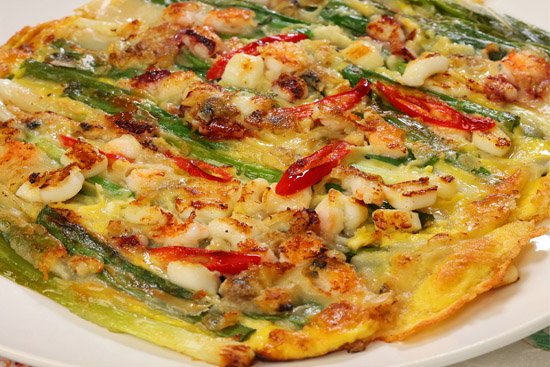
When making pajeon, most Koreans use green onion, and the most popular kind of pajeon is made with seafood. A recipe related to
https://www.maangchi.com
Serves: 2
1 tablespoon potato starch
½ teaspoon kosher salt plus a pinch of salt
a pinch of ground black pepper
¾ cup stock (anchovy kelp stock, chicken stock or vegetable stock), or water
4 tablespoons vegetable oil
12 green onions, roots and tops trimmed to 8 to 9 inches long (to fit your skillet)
4 to 5 ounces (½ cup) seafood (peeled and deveined shrimp, squid, clams), chopped
1 large egg, beaten in a small bowl
1 fresh red pepper, sliced
For dipping sauce:
2 tablespoons soy sauce
1 tablespoon white or apple cider vinegar
½ teaspoon gochu-garu (Korean hot pepper flakes)
1 green onion, chopped
1 teaspoon toasted sesame seeds
Serves: 2
Preparation time:15 minutes
Cooking time:12 minutes
½ cup all-purpose flour1 tablespoon potato starch
½ teaspoon kosher salt plus a pinch of salt
a pinch of ground black pepper
¾ cup stock (anchovy kelp stock, chicken stock or vegetable stock), or water
4 tablespoons vegetable oil
12 green onions, roots and tops trimmed to 8 to 9 inches long (to fit your skillet)
4 to 5 ounces (½ cup) seafood (peeled and deveined shrimp, squid, clams), chopped
1 large egg, beaten in a small bowl
1 fresh red pepper, sliced
For dipping sauce:
2 tablespoons soy sauce
1 tablespoon white or apple cider vinegar
½ teaspoon gochu-garu (Korean hot pepper flakes)
1 green onion, chopped
1 teaspoon toasted sesame seeds
dipping sauce:
1. Put soy sauce, vinegar, gochu-garu, green onion, and sesame seeds in a small bowl.
2. Mix and set it aside.
3. Prepare pancake ingredients:
1. Combine the chopped seafood, pinch of salt and a pinch of ground black pepper in a small bowl. Mix it well and set aside.
2. Combine flour, potato starch, ½ teaspoon salt, and ¾ cup stock (or water) in a large enough to accommodate the green onions. Mix with a whisk until smooth.
Make green onion pancake:
1. Heat 2 tablespoons of the vegetable oil in a large nonstick skillet over medium-high heat and swirl to coat evenly.
2. Add the green onions to the batter to coat them. Using tongs or your hand, place them side by side in the skillet, alternating white end to green end, so they form a neat rectangle.
3. Add the seafood to the leftover batter in the bowl. Using your hands or tongs, spread the battered seafood on top of the battered scallions, scraping out any excess batter remaining in the bowl.
4. Add the sliced red pepper and pour the beaten egg over top of the pancake in the skillet.
5. Quickly wash your hands!
6. Reduce the heat to medium and cook for about 6 minutes, until the bottom is light brown and crispy.
7. Turn the pancake over with a large spatula. Drizzle the remaining 2 tablespoons vegetable oil around the edges of the skillet. Lift one edge of the pancake with your spatula and tilt the skillet so that the oil flows underneath the pancake. Cook for another 3 minutes until nicely browned and crisp.
8. Turn the pancake over again. Turn up the heat to medium high heat and cook for 1 minute, until the bottom turns crunchy.
9. Transfer to a large plate, with the egg and seafood side up. Serve right away with the dipping sauce.
How to eat:
1. Mix the dipping sauce with a spoon. You can cut up the large pancake into several pieces before eating. Take 1 piece to a small individual plate and drizzle some dipping sauce with the spoon and eat. If you don’t want to precut the pancake, you can use your chopsticks to tear off a chunk of batter with a green onion and seafood, and then eat it with the dipping sauce. I prefer the second way because I love to eat the whole cooked green onion.
1. Put soy sauce, vinegar, gochu-garu, green onion, and sesame seeds in a small bowl.
2. Mix and set it aside.
3. Prepare pancake ingredients:
1. Combine the chopped seafood, pinch of salt and a pinch of ground black pepper in a small bowl. Mix it well and set aside.
2. Combine flour, potato starch, ½ teaspoon salt, and ¾ cup stock (or water) in a large enough to accommodate the green onions. Mix with a whisk until smooth.
Make green onion pancake:
1. Heat 2 tablespoons of the vegetable oil in a large nonstick skillet over medium-high heat and swirl to coat evenly.
2. Add the green onions to the batter to coat them. Using tongs or your hand, place them side by side in the skillet, alternating white end to green end, so they form a neat rectangle.
3. Add the seafood to the leftover batter in the bowl. Using your hands or tongs, spread the battered seafood on top of the battered scallions, scraping out any excess batter remaining in the bowl.
4. Add the sliced red pepper and pour the beaten egg over top of the pancake in the skillet.
5. Quickly wash your hands!
6. Reduce the heat to medium and cook for about 6 minutes, until the bottom is light brown and crispy.
7. Turn the pancake over with a large spatula. Drizzle the remaining 2 tablespoons vegetable oil around the edges of the skillet. Lift one edge of the pancake with your spatula and tilt the skillet so that the oil flows underneath the pancake. Cook for another 3 minutes until nicely browned and crisp.
8. Turn the pancake over again. Turn up the heat to medium high heat and cook for 1 minute, until the bottom turns crunchy.
9. Transfer to a large plate, with the egg and seafood side up. Serve right away with the dipping sauce.
How to eat:
1. Mix the dipping sauce with a spoon. You can cut up the large pancake into several pieces before eating. Take 1 piece to a small individual plate and drizzle some dipping sauce with the spoon and eat. If you don’t want to precut the pancake, you can use your chopsticks to tear off a chunk of batter with a green onion and seafood, and then eat it with the dipping sauce. I prefer the second way because I love to eat the whole cooked green onion.
Appetizer Ssamjang korean dipping sauce 

You can store unused portion of ssamjang in an air tight container and refrigerate until needed. From a food safety perspective consume within 3-5 days.
** If you want to learn more about Korean ingredients, see essential Korean grocery ingredients!
Serves: 6
2 Tbsp gochujang (Korean chili paste)
2 Tbsp toasted sesame oil
1/2 Tbsp honey
2 tsp toasted sesame seeds
1/2 tsp minced garlic
10g / 0.35 ounces onion, thinly sliced
(optional) 2 Tbsp walnuts (or your choice of nuts and seeds) – this will add nuttier flavor and creamier texture.
(optional) 10g / 0.35 ounces apple, cored and cut into small pieces
Serves: 6
Preparation time:5 minutes
1/4 cup doenjang (Korean soybean paste)2 Tbsp gochujang (Korean chili paste)
2 Tbsp toasted sesame oil
1/2 Tbsp honey
2 tsp toasted sesame seeds
1/2 tsp minced garlic
10g / 0.35 ounces onion, thinly sliced
(optional) 2 Tbsp walnuts (or your choice of nuts and seeds) – this will add nuttier flavor and creamier texture.
(optional) 10g / 0.35 ounces apple, cored and cut into small pieces
Put all ingredients in a food processor and blend until the texture is smooth. It will takes about 1 min. Transfer the sauce into a serving bowl. Garnish with the green onion and sesame seeds.
Main Korean honey sesame grilled chicken 

Serves: 6
Preparation time:25 minutes
Cooking time:15 minutes
For the rub:1½ tablespoons extra virgin olive oil
1 tablespoon sweet paprika
1 teaspoon garlic salt
½ teaspoon sugar
For the glaze/sauce:
½ cup low sodium soy sauce
¼ cup honey
2 tablespoons hoisin sauce
1½-3 tablespoons Korean Gochujang to taste
2 tablespoons finely grated fresh ginger
2 tablespoons sesame oil
2 garlic cloves, finely minced
1 ½ tablespoon grainy mustard
1 tablespoon sesame seeds, more for garnish, if desired
For the chicken:
2 pounds trimmed boneless skinless chicken thighs or chicken breasts
For the rub:
Combine olive oil, paprika, garlic salt, and sugar in a medium size bowl. Stir well to combine then add the chicken and turn several times to coat. I like to use my hands to massage the rub into the chicken.
Cover the bowl and refrigerate for at least 30 minutes or as long as 24 hours.
For the glaze/sauce
Combine all ingredients in a medium-size sauce pan and stir well. Bring to a boil and cook for 5 -7 minutes, until sauce thickens and is reduced by about one half. (Maintain a steady, medium boil but reduce the heat a bit if the mixture boils up too high.) Taste and if you’d like it a little spicier, add another tablespoon of Gochujang. Repeat to taste. Set aside to cool down.
For grilling the chicken:
Heat a grill to high (500-600˚F). Clean and oil the grates.
Place the chicken on the grill; cook for 3-4 minutes on the first side, or until golden brown. Flip to the opposite side and brush the cooked side with some of the glaze. Grill the second side for 3-4 minutes then flip and brush with the glaze. Continue cooking for 1-2 minutes more on each side, brushing with the glaze after flipping until the chicken is browned and nicely charred in spots.
Transfer the chicken to a serving platter and allow to rest for a few minutes before slicing. Serve any extra sauce with the chicken.
Combine olive oil, paprika, garlic salt, and sugar in a medium size bowl. Stir well to combine then add the chicken and turn several times to coat. I like to use my hands to massage the rub into the chicken.
Cover the bowl and refrigerate for at least 30 minutes or as long as 24 hours.
For the glaze/sauce
Combine all ingredients in a medium-size sauce pan and stir well. Bring to a boil and cook for 5 -7 minutes, until sauce thickens and is reduced by about one half. (Maintain a steady, medium boil but reduce the heat a bit if the mixture boils up too high.) Taste and if you’d like it a little spicier, add another tablespoon of Gochujang. Repeat to taste. Set aside to cool down.
For grilling the chicken:
Heat a grill to high (500-600˚F). Clean and oil the grates.
Place the chicken on the grill; cook for 3-4 minutes on the first side, or until golden brown. Flip to the opposite side and brush the cooked side with some of the glaze. Grill the second side for 3-4 minutes then flip and brush with the glaze. Continue cooking for 1-2 minutes more on each side, brushing with the glaze after flipping until the chicken is browned and nicely charred in spots.
Transfer the chicken to a serving platter and allow to rest for a few minutes before slicing. Serve any extra sauce with the chicken.
Main Singapore noodles 
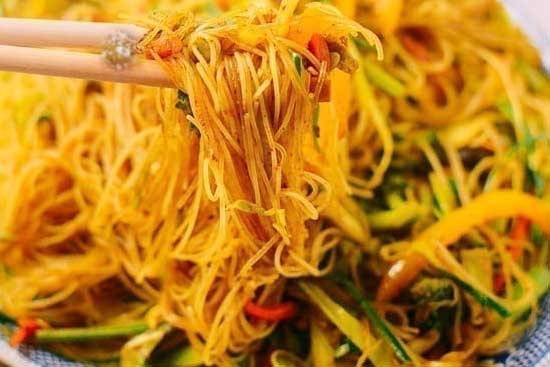
Serves: 4
Preparation time:15 minutes
Cooking time:15 minutes
8 oz vermicelli rice noodles1 tbsp mild curry powder
¼ tsp turmeric
1 tsp sugar
1 tbsp sesame oil
3 tbsp low-salt soy sauce
1 tbsp vegetable oil
1 cup sliced onion
1 sweet pepper, yellow or orange
6 oz bean sprouts
1 red chilli, sliced (optional)
Soften the noodles in a large pan of boiling water to cover, pushing the noodles under the water. Set aside for 5-10 minutes, until the noodles are completely soft. Mix the curry powder, turmeric, sugar, sesame oil, soy sauce and 1 tbsp water in a bowl.
Heat a wok until very hot. Add the sunflower oil, onion and pepper. Stir-fry for 3-4 minutes until softened and starting to brown in places. Drain the noodles and add to the pan, along with the sauce mixture and bean sprouts. Stir-fry for a further 3-4 minutes, tossing everything through the sauce, until hot. Adjust the seasoning with a little more soy or sugar, if you like, and scatter over the chilli, if you like more spice.
Heat a wok until very hot. Add the sunflower oil, onion and pepper. Stir-fry for 3-4 minutes until softened and starting to brown in places. Drain the noodles and add to the pan, along with the sauce mixture and bean sprouts. Stir-fry for a further 3-4 minutes, tossing everything through the sauce, until hot. Adjust the seasoning with a little more soy or sugar, if you like, and scatter over the chilli, if you like more spice.
conversion of liquids
Weights
Temperatures
Measures of non liquid ingredients
Non-liquid ingredients in volume converted
|
|||||||
|---|---|---|---|---|---|---|---|
Ingredient |
1 cup |
3/4 cup |
2/3 cup |
1/2 cup |
1/3 cup |
1/4 cup |
2 tablespoons |
| All-purpose wheat flour | 120 g | 90 g | 80 g | 60 g | 40 g | 30 g | 15 g |
| All-purpose sifted wheat flour | 110 g | 80 g | 70 g | 55 g | 35 g | 27 g | 13 g |
| White sugar | 200 g | 150 g | 130 g | 100 g | 65 g | 50 g | 25 g |
| Powdered sugar/Icing sugar | 100 g | 75 g | 70 g | 50 g | 35 g | 25 g | 13 g |
| Brown sugar normally packed | 180 g | 135 g | 120 g | 90 g | 60 g | 45 g | 23 g |
| Corn flour | 160 g | 120 g | 100 g | 80 g | 50 g | 40 g | 20 g |
| Cornstarch | 120 g | 90 g | 80 g | 60 g | 40 g | 30 g | 15 g |
| Rice (not-cooked) | 190 g | 140 g | 125 g | 95 g | 65 g | 48 g | 24 g |
| Macaroni (uncooked) | 140 g | 100 g | 90 g | 70 g | 45 g | 35 g | 17 g |
| Couscous (uncooked) | 180 g | 135 g | 120 g | 90 g | 60 g | 45 g | 22 g |
| Quick oatmeal (uncooked) | 90 g | 65 g | 60 g | 45 g | 30 g | 22 g | 11 g |
| Table salt | 300 g | 230 g | 200 g | 150 g | 100 g | 75 g | 40 g |
| Butter / Margarine | 240 g | 180 g | 160 g | 120 g | 80 g | 60 g | 30 g |
| Shortening | 190 g | 140 g | 125 g | 95 g | 65 g | 48 g | 24 g |
| Fruits and légumes chopped | 150 g | 110 g | 100 g | 75 g | 50 g | 40 g | 20 g |
| chopped walnuts | 150 g | 110 g | 100 g | 75 g | 50 g | 40 g | 20 g |
| Nuts /ground almonds | 120 g | 90 g | 80 g | 60 g | 40 g | 30 g | 15 g |
| Fresh bread crumbs (not packed) | 60 g | 45 g | 40 g | 30 g | 20 g | 15 g | 8 g |
| Dry bread crumbs | 150 g | 110 g | 100 g | 75 g | 50 g | 40 g | 20 g |
| Parmesan grated | 90 g | 65 g | 60 g | 45 g | 30 g | 22 g | 11 g |
| Chocolate chips | 150 g | 110 g | 100 g | 75 g | 50 g | 38 g | 19 g |
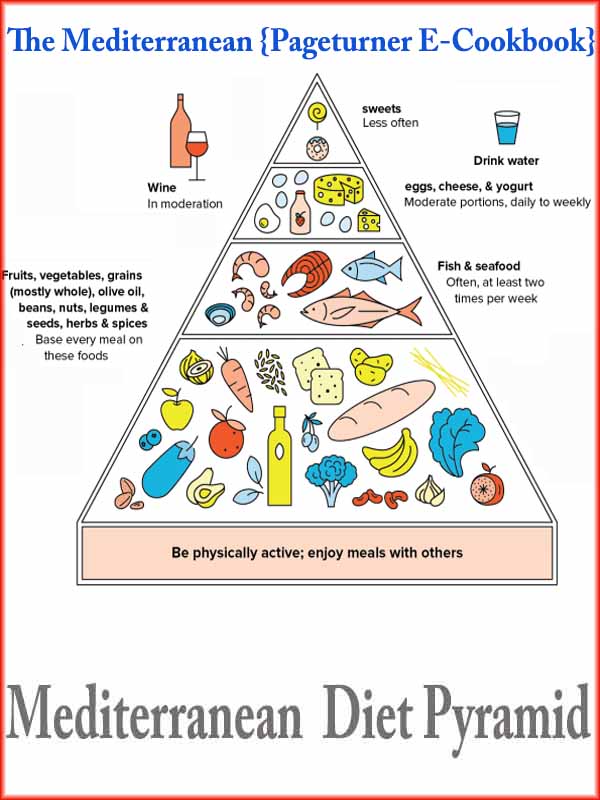

As the sun rises or sets in
KOREA
"May every sunrise hold more promise, and every sunset hold more peace."
The {Page Turner} E-Cookbooks
Library on a world cooking journey
5 Recipes
3 Appetizers
2 Main dishes








